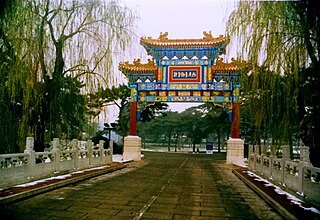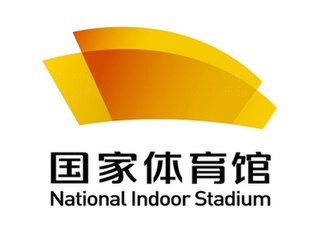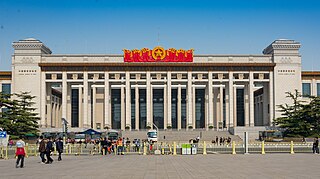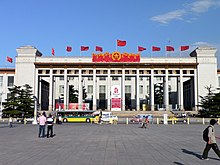
The Great Hall of the People is a state building situated to the west of Tiananmen Square in Beijing. It is used for legislative and ceremonial activities by the government of the People's Republic of China. The People's Great Hall functions as the meeting place for the full sessions of China's legislature, the National People's Congress, which occurs every year during March along with the national session of the Chinese People's Political Consultative Conference, a political advisory body. The Great Hall is also the meeting place of the National Congress of the Chinese Communist Party, which, since the 12th conference in 1982, has occurred once every five years, and the party's Central Committee which meets approximately once a year.

Beijing railway station, or simply Beijing station, is a passenger railway station in Dongcheng District, Beijing. The station is located just southeast of the city centre inside the Second Ring Road with Beijing Station Street to the north and the remnants of the city wall between Chongwenmen and Dongbianmen to the south. The Beijing railway station opened in 1959 and was the largest train station in China at the time. Though superseded by the larger Beijing West and Beijing South stations, this station remains the only one located inside the old walled city. Trains entering and leaving the station pass by the Dongbianmen corner tower. With gilded eaves and soaring clock towers, the architecture of the railway blends traditional Chinese and socialist realist influence.

Chang'an Avenue, literally "Eternal Peace Street", is a major thoroughfare in Beijing, China.

The Beijing Hotel is a five-star state-owned hotel complex in the Dongcheng District of Beijing, China. It is located at the southern end of Wangfujing Street, at the corner with East Chang'an Avenue, 1.5 km from Beijing railway station with views of the Forbidden City and part of Tiananmen Square.

The Chairman Mao Memorial Hall, also known as the Mausoleum of Mao Zedong, is the final resting place of Mao Zedong, Chairman of the Politburo of the Chinese Communist Party from 1943 and the Chairman of the Chinese Communist Party from 1945 until his death in 1976.

The Diaoyutai State Guesthouse (DSG) (simplified Chinese: 钓鱼台国宾馆; traditional Chinese: 釣魚臺國賓館; pinyin: Diàoyútái Guóbīnguǎn) is an ancient royal garden and modern state guesthouse-complex located on the east side of Yuyuantan Park in Haidian District, Beijing, China. Emperor Zhangzong of Jin once built a fishing platform here, thus the name "Diaoyutai", which has a history of more than 800 years. During the Qing Dynasty, the Qianlong Emperor ordered to dredge the Yuyuantan and build a palace here, which was then turned into a royal garden. The modern State Guesthouse Park was built by the government of the People's Republic of China in 1958-1959 on the basis of the ancient Diaoyutai Scenic Spot, as a place for visiting dignitaries to stay and for meetings and conferences. Diaoyutai State Guesthouse is located outside Fuchengmen in western Beijing, east of Yuyuantan, southwest of the intersection of Fucheng Road and Sanlihe Road.

The National Indoor Stadium (国家体育馆), a.k.a Folding Fan (折扇), is an arena located at Olympic Green in Chaoyang, Beijing, China.

The National Museum of China is an art and history museum located on the eastern side of Tiananmen Square in Beijing. The National Museum of China has a total construction area of about 200,000 square meters, a collection of more than 1.4 million items, and 48 exhibition halls. It is the museum with the largest single building area in the world and the museum with the richest collection of Chinese cultural relics. It is a level-1 public welfare institution funded by the Ministry of Culture and Tourism.

The China Railway Museum is a Chinese museum preserving locomotives that have operated on the railways of the People's Republic of China. The museum offers a total exhibition space of 16500m² and 8 exhibition tracks.

The China Ethnic Museum is a museum in Beijing, China, located just to the west of the Olympic Green. It features displays of the daily life and architecture of China's 56 ethnic groups.

Military Museum station is an interchange station on Line 1 and Line 9 of the Beijing Subway. It located near the Military Museum of the Chinese People's Revolution. Line 9 did not stop at this station until 21 December 2013.

The Beijing Exhibition Center was established in 1954 as a comprehensive exhibition venue in Beijing, China. Built in the Sino-Soviet architectural style that was popular in the 1950s, the Beijing Exhibition Center contains three large exhibition halls as well as museums.
Qi Kang, is a Chinese architect, also an artist. He is a supervisor in Southeast University, Academician of Chinese Academy of Sciences, Foreign Academician of French Academy of Architecture, and Director of Research Institute of Architecture of Southeast University.

The Cultural Palace of Nationalities (民族文化宫) is located in Beijing's Xicheng District, on West Chang'an Avenue. Built in September 1959, it is one of the Ten Great Buildings and was registered as the first of 55 museums in the city. The building houses a museum, an art gallery, a library, an art institute, a theater, a guesthouse, and other facilities. It is under the administration of the State Ethnic Affairs Commission of the People's Republic of China.

The former residence of Soong Ching Ling is a museum in the Shichahai area of Beijing, China, and once was the last residence of Soong Ching-ling, the wife of Sun Yat-sen and later Vice-President and Honorary President of the People's Republic of China in 1981. The museum opened in 1982, while it was listed as a National Key Cultural Relic Protection Unit. It was renovated in 2009, and is dedicated to her memory.

The Beijing Liao and Jin Dynasty City Wall Museum is a museum built over the ruins of Beijing's Liao and Jin dynasty (1115–1234) city wall. The museum is located at No.41 Yulinli, Yulin South Road, in Fengtai District of southwestern Beijing, near the north bank of the Liangshui River.

Located at Yangfangdian Road, Haidian, Beijing, the Jingxi Hotel is subordinate to the Agency for Offices Administration of the Central Military Commission, and is a high-profile hotel for government officials and an internal meeting place, which located near the Military Museum and Defense Ministry. It was the residence of the delegates of the Military Commission during the Congress, and successive leaders of the Party and the State have attended many relevant meetings in the hotel.

Beijing Library is located north of the Central Green Forest Park in Tongzhou District, Beijing, and is one of the three major buildings in the Beijing Municipal Administrative Center. It was completed and opened on December 27, 2023, forming the "One Library, Three Locations" pattern with the Hua Wei Qiao branch and the Daxing Airport branch of Capital Library. The Library houses functional areas such as ancient literature and documents, intangible cultural heritage, open-stack reading areas, smart libraries, and lecture halls, providing reading and learning facilities.

Xihuang Temple is a Buddhist temple located in Chaoyang District, Beijing.
Lhasa Mass Culture and Sports Center, located in Liwu New District, Lhasa, Tibet Autonomous Region, is a comprehensive venue integrating stadium, gymnasium and Tibet Yak Museum, and is also the highest elevation modern stadium in the world.






















